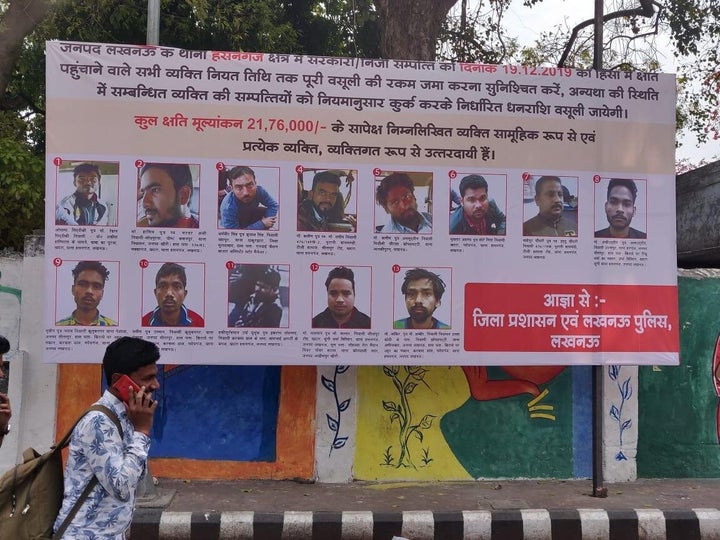
NEW DELHI — People whose personal details have been put up on large hoardings by the Bharatiya Janata Party (BJP) government in Uttar Pradesh, allegedly for damage to public property during protests against the Citizenship Amendment Act (CAA) and the National Register of Citizens (NRC), say they now fear for the safety of their families.
The hoardings, which have been put up by the Yogi Adityanath-led state government in Lucknow, include the names, photos and even addresses of at least 50 people, including social and political activists in Lucknow, who had joined the protests in December.
These activists are now questioning how it is even legal for the state to disregard the privacy and security of Indian citizens in this manner.
“It is as if the government has opened us up to a mob attack,” said Sadaf Jafar, an activist and a member of the Congress, who was arrested on 19 December for participating in an anti-CAA protest. Jafar, who was granted bail by the district court in Lucknow, has alleged that she was beaten and tortured while in custody of the UP Police.
“What if a mob comes with guns, what will I do? What if they catch my hair and drag me away, what will I do?” she said. “How inhuman, how insane and how idiotic is this?”
While the UP Police have accused many protesters of violent crimes, the district court in Lucknow has granted several of them bail, pointing to the lack of evidence.
The police force in states such as Delhi and Karnataka had also tried to quell the anti-CAA protests through violence, but Uttar Pradesh was particularly brutal in cracking down on protesters. HuffPost India reported that at least five children detained during the protests were tortured in custody.
Adityanath himself had called for his government to take ‘revenge’ against the protesters, warning them that their property would be auctioned off to pay for the damages. After several activists alleged that they were assaulted in custody, a minister in Adityanath’s government told HuffPost India that the government would not investigate these claims, and anyone alleging mistreatment could move the courts or approach the SITs set up to investigate the violence.
Jafar, a mother with two children, said that she was horrified at the thought that any number of people could take photos of her photo and her address and save it on their mobile phones.
Even when she went to see the hoarding for herself, Jafar said she saw a stranger looking at the photo and then comparing it with her face. “I thought I was going to get beaten up there,” she said. “It is an era where they can do anything.”
The hoardings, which have come up in four police station areas — Hazratganj, Thakurganj, Hasanganj and Qaiserbagh — say the persons identified have to pay for the damage done to public or private property or the government will attach their properties.
Legal analysts say the UP government’s move to identify people and recover damages is problematic because it does not follow the procedure laid out by the Supreme Court, which made the state high court responsible for assessing damage, assigning accountability, and determining compensation. This exercise has to be overseen by a retired high court or district judge in the capacity of a claims commissioner.
The hoardings have come up even as a petition challenging the government’s move is pending before the Supreme Court. On 1 February 2020, the Supreme Court had sent a notice to the UP government, giving it four weeks to respond to a petition seeking the quashing of recovery notices.
S.R. Darapuri, a social activist and retired Indian Police Service (IPS) officer, whose name, photo and address are now also on display in Lucknow, said that he had never seen anything like this in his career as a police officer.
“This is completely illegal. This is only for naming and shaming. This is to terrorise the public so that no one dares to raise their voice,” he said.
Darapuri, who had also been arrested in December, said that activists would move the Allahabad High Court against the hoardings. He added that he was writing to the Home Secretary and the Director General of Police in Uttar Pradesh, saying the hoardings were a threat to the life and liberty of those named, and they would hold the state responsible for anything that happened as a consequence.
The other activists in the hoardings include Mohammed Shoaib, a human rights lawyer in his seventies, Pawan Rao Ambedkar, a Dalit activist, Robin Verma, a teacher, and Deepak Kabir, a cultural activist.
Ambedkar, Verma and Kabir have alleged that the UP Police beat them when they were in custody following the anti-CAA protest on 19 December 2020.
Kabir said that he was an ordinary citizen, not a politician who moved around with security guards.
“We drop our children to school. We step out for milk,” said Kabir. “In this environment of mob violence and lynching, the government is exposing us to incredible danger. This is completely unethical.”